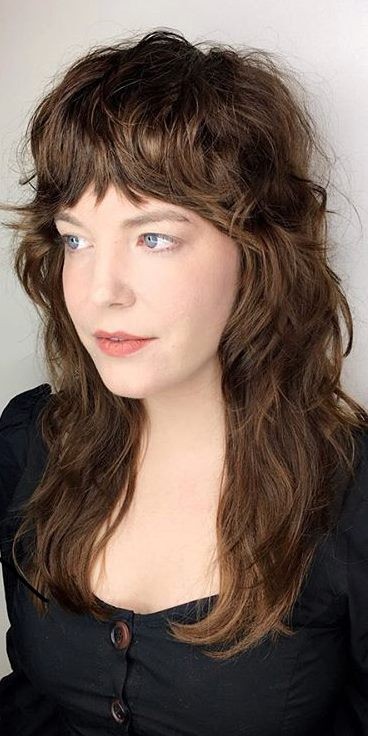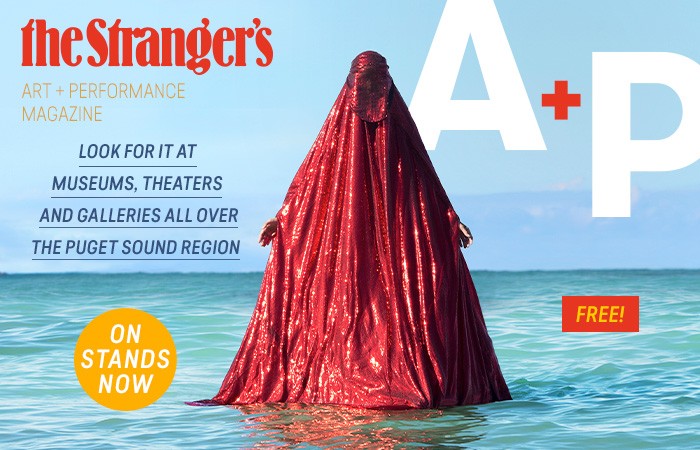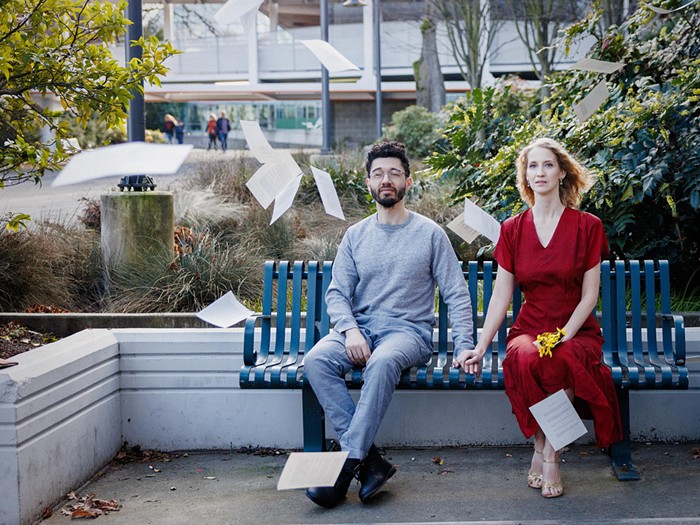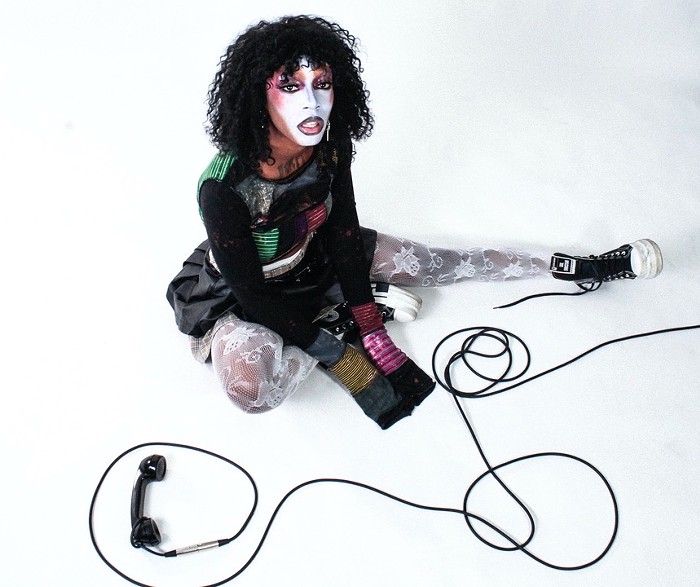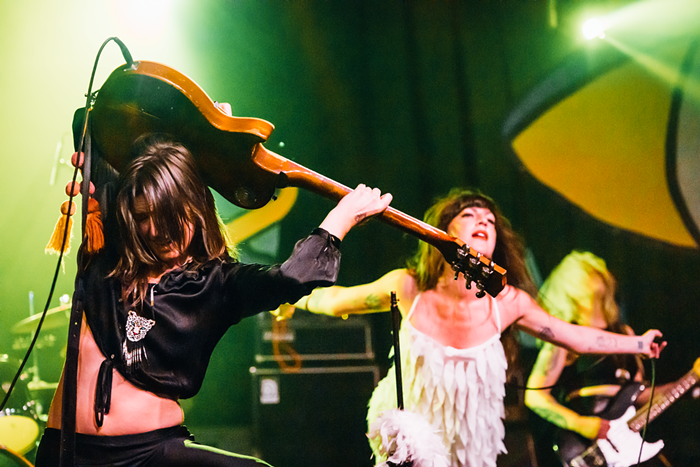What the Hell Is Make Believe Seattle?
Finally, a Film Festival for Fellow Weirdos
The Power of Making People of Color Invisible
Stephanie Syjuco Empowers the Oppressed with Just a Finger
Better, Stronger, Faster
The Seattle Repertory Jazz Orchestra Pays Tribute to the Legendary Oliver Nelson
Where to Pickup a Copy of The Stranger's Spring A+P 2024
Find it at Hundreds of Locations Around Seattle!
Queen of Our World
When Sasha taqwšəblu LaPointe Writes, the Revolution’s Coming
Blowing Minds and Melting Faces
Thunderpussy Celebrate Their Survival with a Surprising Benaroya Hall Takeover
Person of Interest: Arson Nicki
Finally, a Fashion Expert for the People
Six Films You Need to See at Make Believe Seattle
Starring Ethical Vampires, Ridiculous Puppets, and a Dude Who Pretends to Be George Lucas for Funsies
Art, Illness, and Auto Repair
Cherdonna Makes a Compassionate Comeback
Person of Interest: TeZATalks
Harbinger of Horror-Filled Hardcore Pop
It’s Important That the Bug Undulates
How Anida Yoeu Ali Uses Wiggling Worms and Glitter as Forms of Protest
Sincerely Joking
Chastity Belt Live, Laugh, and Love 10 Years On
Your Spring Arts Itinerary
24 of This Season’s Very Best Art, Books, Music, Film, Theater, and Food Events
Tessa Hulls’s Feeding Ghosts Is Instant Canon Fodder
Too Bad She’ll Never Write Another Graphic Novel
Isabel Hagen’s Comedy Strings You Along
How a Juilliard-Trained Violist Found Harmony as a Stand-Up Comedian
Person of Interest: Taha Ebrahimi
Seattle’s Coolest Street Tree Expert
Anida Yoeu Ali deals heavily in dichotomies and paradoxes. As a first-generation Muslim Khmer artist born in Cambodia and raised in Chicago, Ali’s works tease out the spiritual and political underpinnings of her hybrid transnational identity. Her textile works simultaneously veil and draw attention to the form that wears them; in performance, she becomes both dazzling and obscured, a solitary mythopoetic entity who also fosters face-to-face public encounters. Ali identifies as a political agitator, and she’s one you might have spotted before. On November 9, 2016, the day after Donald Trump was elected president, she appeared in the center of Pike Place Market as the Red Chador, carrying a sign: I AM A MUSLIM on one side, BAN ME on the other.
Hybrid Skin, Mythical Presence, Seattle Asian Art Museum’s first solo exhibition of a Cambodian American artist, celebrates two of Ali’s most monumental performance installations: The Buddhist Bug, a 300-foot undulating worm who represents both Islam and Buddhism, and The Red Chador, a glittering protester of Islamophobia who emerged, died, and was reborn again, a rainbow-hued phoenix from the ashes.
Ahead of her performances this spring, I spoke with Ali about absurdity, grief, the diasporic dilemma, cosmogonies, and Dune.
How did you land on the title of your exhibition, Hybrid Skin, Mythical Presence?
A lot of my performance installation work uses textiles, which I consider to be an extension of my skin and a way to extend my body into public space. It’s a metaphor for when I used to write poetry—the words would fill a space. Those words were often narrative-driven, but they failed me internationally. When I started to share the English-based spoken-word poetry with an international audience, it fell short. People didn’t understand the nuance of the stories in the work. They would understand that I was angry or enraged or passionate, but they missed the stories themselves because of the translation, or because it was, to them, a foreign language.
So I made a shift. From 2004 on, I started to develop performance installations and create things that were more rooted in being silent, using performative gestures, colors, and textiles. Essentially, it made sense to use the word hybrid [in the show title] because my work has always been a fusion, and my identity as someone who’s multi-ethnic is a fusion of multiple cultures. Hybrid Skin, Mythical Presence made sense because I was also thinking about heroine figures and the creation of larger-than-life personas. Each time I create them, it feels like they are all rooted in a creation mythology.
I’m interested in how you center textiles in your performances, particularly wearables. When you wear these pieces, do you enact any specific mythical heroines—feminist, queer, or otherwise? Or are you constructing a character that’s entirely your own?
It’s the latter. I’m completely constructing it—an entity that’s different, new, original to me. These entities are, in many ways, grabbing onto people’s curiosities. In the case of The Buddhist Bug, the creature moves very, very slowly and has no arms, but they can beckon people forward, just by motioning and softening with their eyes. [Ali uses “they” and “she” interchangeably when referring to the bug.]
I think the most memorable instance of this was in Malaysia. There was a patron who visited a gallery there who I was told later was a pretty difficult person. This man was standing in the doorway for a while, and he was so curious: Why is this woman artist in this orange, worm-like creature outfit? What is he supposed to do? I had a moment of locking eyes with him and beckoning him forward. He got down on his knees. We smiled, and then he let me put my head on his shoulders.
I think that these performances are powerful to witness and powerful to experience. That’s what I love about the costumes being wearable—they become part of me, and I take on these characters, but each one is also semi-autobiographical. There is an element of science fiction in them; they have my love of flamboyant fashion. I’m also thinking about the bug representing both Islam and Buddhism and the Red Chador being Muslim and Catholic. I have a real love for Catholic pageantry, bishops, cardinals, and their regalia. I think of these wearables as a kind of regalia.
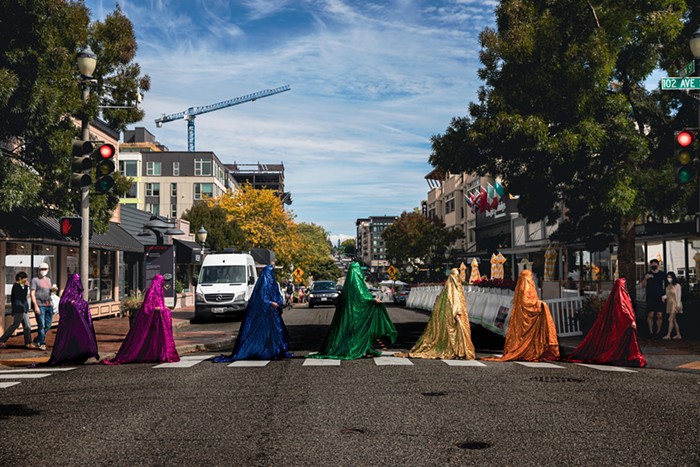
The story you just told brings me to another question I had about the bug. I saw a video on your Instagram feed of children exploring and playing around the bug in the museum space. Could you elaborate on your choice to snake this 300-foot piece throughout the gallery? How do you envision the sheer physicality of it landing with viewers, and how does that physicality tie in with the wider themes of the work?
The bug often becomes an immersive installation. I want people to come up close, to extend the narrative of the bug further. It’s made of soft textile—just thread, tubing, and fabric. I do very simple sketches; I have no 3D modeling going in. Sometimes it’s difficult for installers to understand my process. It’s important that the bug undulates.
When you’re looking at the sculpture, you’re looking at an entity that is trying to figure out why and how their body fits into the space. It’s an amazing structure and precious to me, but not so precious that the viewer doesn’t get to be close to it. It’s very important that they are immersed in it, and that they see the complexity of the twists and turns. When it’s down on the ground and trying to move up, it is trying to discover itself.
I love it when kids have that moment of wonder when they enter the space. That’s the interventionist quality of my work, that aspect of absorbing you into the world of the bug, which is so orange. That concept comes from my experience of overwhelm as an ethnic minority in Cambodia, where it’s 98% Buddhist. When you travel to Southeast Asia, you do feel the overwhelming presence of Buddhism. It’s everywhere. It’s reflected through the saffron robes of the Buddhist monks. I realized how hard my parents tried to give us their Islamic culture because that was what they prized and that was what got them through the genocidal period—preserving that part of our heritage as Cambodian Muslims.
I’ve read that you also describe the bug as an assertion of paradoxes. Can you speak more about the paradoxes that you see within this fluctuating, stretchy being?
I think that, to me, paradox is also rooted in the complexity of what is called a diasporic dilemma—constantly fluctuating between insider and outsider perspectives at any one point. You’re never quite an American in America. You’re never quite Cambodian in Cambodia. When the bug is in Cambodia, they traverse through the rural and the urban. It’s also playing on nostalgic ruminations. Often, diasporic people have an idea of the motherland that’s rooted in their parents’ past and ideals. The ideal landscapes that we think of as quintessentially Cambodian are often rooted in rurality. You see the bug traveling through these luscious rural landscapes—a lagoon, palm trees, rice fields—and they emerge out into the city of Phnom Penh, with rapid urbanization and rapid globalization.
The bug makes a realistic image surreal—another paradox I’m setting up. What is going on in this picture? What is it that the bug is trying to mediate at this moment? What am I looking at, and why? In most of the images, people are not looking into the camera or not even mindful of the bug’s presence. Maybe one or two people will gawk, but everybody else is going about their business. That’s done intentionally—the bug thinks they belong perfectly in a classroom amongst Cambodian children [for example], but as their body coils around the room, their classmate looks at them a little strangely. So perhaps they don’t belong, or they’ve been questioned about whether they belong in this place.

Speaking of the surreality of the bug character, can we talk a little bit about your choice to inject your work with absurd humor? Is that a more recent choice for you?
It’s an extension of my personality, for sure. When I was making spoken-word work and my one-woman show, the work was heavy and dealt with personal history—my rage as a young Asian American woman growing up in America. I felt like, Wow, being political really makes you serious. Those who know me know my ridiculousness and my strong sense of humor, but it wasn’t coming out in the work. That was when I shifted to creating these personas. Being in silence made the work more complex. The humor and the absurdity emerged through creating an entity out of enormous amounts of fabric. It’s over the top. The Islamic part of [the bug’s design] is modeled after hijab, and the bug is exercising the rules of modest dress in Islam. I’m going over the top in fulfilling those rules of modest dress by only showing the face and the feet.
In the first iteration of The Red Chador, she was an executioner of French baguettes in a 12-hour durational piece at the Palais de Tokyo. Again, I used my sense of humor. She made 12 absurdist demands over 12 hours. They were intended to be rhetorical demands that you couldn’t fulfill unless you thought creatively. I’m holding the baguettes hostage, and if the demand isn’t met, just like a kidnapper, I would then proceed with beheading a French baguette. What surprised me the most in that durational performance was that the French audience was so engaged. They really wanted to save the baguettes.
As the Red Chador, I was a very kind executioner. One of my demands was for someone to bring me all the flags of the former French colonies. A group of students researched and drew all of the flags, then presented the drawings to me. They had to say all the names of the different countries. The French refuse to talk about their colonial pasts, and they refuse to talk about race issues. They don’t even take data on race. As the Red Chador, I said, I will accept this answer. You have fulfilled the demand. Here’s the baguette. The room erupted with clapping. So as absurd as some of these requests were, they weren’t impossible.
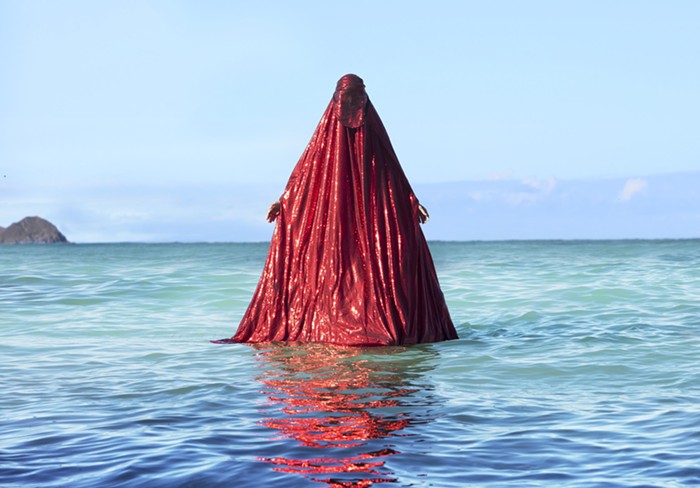
I read that the original Red Chador garment was dubiously lost in transit in Tel Aviv, after which you publicly commemorated, memorialized, and grieved it. You’ve since decided to resurrect the performance. I’m curious if you could explain a little more about that work’s themes, and why it feels important to continue sharing it.
Initially, when the garment disappeared, I needed a period to grieve. It was a really deep loss. I’ve dealt with so much loss within my work—from a gallery fire, to termites, to flood damage, and an assault on my work in 2010. This loss put me in such a horrible place that I didn’t feel like I could recreate the garment at that time. I was really sad for her and how she died—trapped, alone, inside luggage in a dark place, never to see the light of day after the Kuala Lumpur performance, where the last version of the original Red Chador was performed. I’d packed her up in my luggage to come to Tel Aviv for a talk I did in Ramallah. A friend mentioned that I should grieve her properly, and that maybe if I saw [the garment] as a person, not as a persona, then I should give a eulogy.
It wasn’t until 2019, when I had the opportunity for a commissioning residency with the Shangri La Museum of Islamic Art, Culture & Design in Honolulu, that the idea of reclaiming the work arose. I felt disrupted; it was taken from me before The Red Chador was fully realized. This commissioning residency gave me the resources, but it also felt like it was meaningful and poetic to reclaim it in Hawaii. I thought, Why Hawaii? Does this feel like the right moment to reimagine this and add to the creation mythology of the Red Chador? In my research, it felt right that it was an Islamic museum that was supporting the work, and it felt right that it was in Hawaii, because Hawaiian legislatures were the first to stand up against Trump’s attempted Muslim ban.
Also, ānuenue is the word for “rainbow” in Hawaiian. In Hawaiian culture, ānuenue carries bodies. There’s a celestial element to it—it helps to bridge the living and the dead. So I thought, maybe from the cracks of the American empire, this creature could reemerge. That’s part of the creation mythology aspect of the work. I felt that the original work had died alone, and I didn’t want to set that up again. She was rebirthed with friends—a rainbow brigade—that she can now walk with as a strong, protective sisterhood collective. The use of the different colors of the rainbow spectrum in the piece is intentional to align struggles. If I fight Islamophobia, I want to align that with the struggles with homophobia. It’s something that all religious communities need to be interrogating—let’s look at other alignments and let’s create a sense of solidarity and inclusivity.
One last question—I’ve heard you’re a sci-fi fan. Are there any specific sci-fi influences present in this show?
Well, the bug obviously has resonance with [the sandworm] in Dune, and you can see the costuming of the Imperial Guards in Star Wars in The Red Chador. The funny thing is, when I conceive of a project, I don’t intentionally reference sci-fi characters in my sketches or color choices. I realize it later on because I’m such a fan of science fiction that it’s embedded in me.
Hybrid Skin, Mythical Presence is at the Seattle Asian Art Museum through July 7. Anida Yoeu Ali will perform The Buddhist Bug at the Seattle Asian Art Museum Saturday, March 23, 11 am–2 pm. She’ll perform The Red Chador (Afterlife) at the Seattle Art Museum Saturday, June 1, 9 am–3 pm. Tickets to both are available at seattleartmuseum.org.

